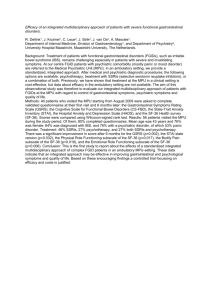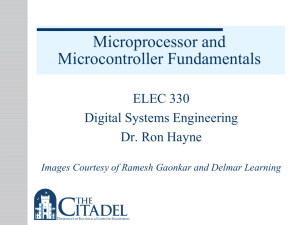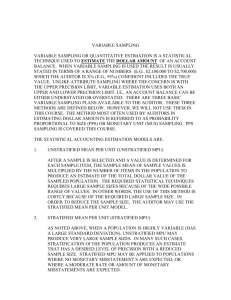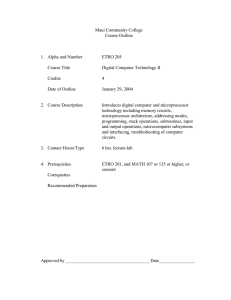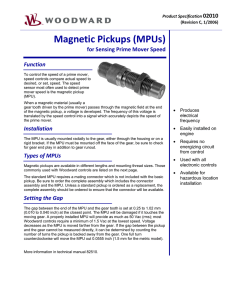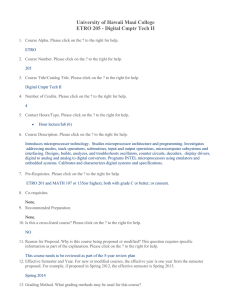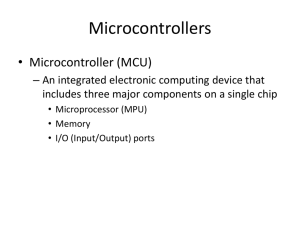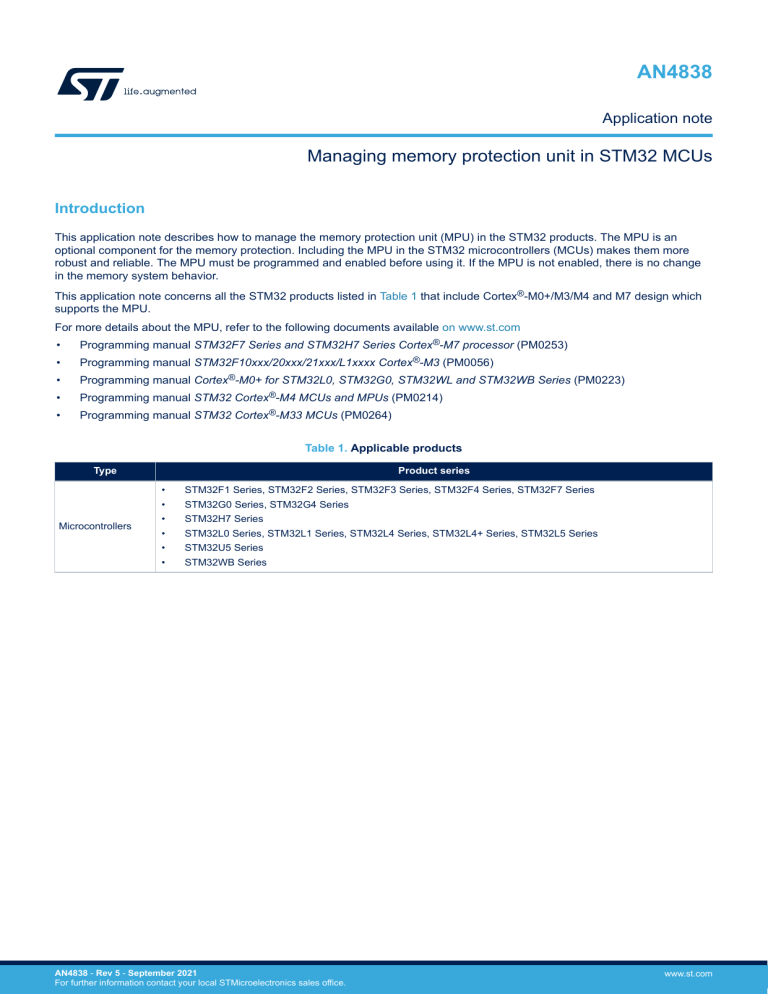
AN4838
Application note
Managing memory protection unit in STM32 MCUs
Introduction
This application note describes how to manage the memory protection unit (MPU) in the STM32 products. The MPU is an
optional component for the memory protection. Including the MPU in the STM32 microcontrollers (MCUs) makes them more
robust and reliable. The MPU must be programmed and enabled before using it. If the MPU is not enabled, there is no change
in the memory system behavior.
This application note concerns all the STM32 products listed in Table 1 that include Cortex®-M0+/M3/M4 and M7 design which
supports the MPU.
For more details about the MPU, refer to the following documents available on www.st.com
•
Programming manual STM32F7 Series and STM32H7 Series Cortex®-M7 processor (PM0253)
•
Programming manual STM32F10xxx/20xxx/21xxx/L1xxxx Cortex®-M3 (PM0056)
•
Programming manual Cortex®-M0+ for STM32L0, STM32G0, STM32WL and STM32WB Series (PM0223)
•
Programming manual STM32 Cortex®-M4 MCUs and MPUs (PM0214)
•
Programming manual STM32 Cortex®-M33 MCUs (PM0264)
Table 1. Applicable products
Type
Microcontrollers
Product series
•
STM32F1 Series, STM32F2 Series, STM32F3 Series, STM32F4 Series, STM32F7 Series
•
STM32G0 Series, STM32G4 Series
•
STM32H7 Series
•
STM32L0 Series, STM32L1 Series, STM32L4 Series, STM32L4+ Series, STM32L5 Series
•
STM32U5 Series
•
STM32WB Series
AN4838 - Rev 5 - September 2021
For further information contact your local STMicroelectronics sales office.
www.st.com
AN4838
General information
1
General information
This application note applies to STM32 microcontrollers Arm®-based devices.
Note:
AN4838 - Rev 5
Arm is a registered trademark of Arm Limited (or its subsidiaries) in the US and/or elsewhere.
page 2/20
AN4838
Overview
2
Overview
The MPU can be used to make an embedded system more robust and more secure by:
•
•
•
prohibiting the user applications from corrupting data used by critical tasks (such as the operating system
kernel)
defining the SRAM memory region as a non-executable (execute never XN) to prevent code injection attacks
changing the memory access attributes
The MPU can be used to protect up to sixteen memory regions. In Armv6 and Armv7 architecture (Cortex-M0+,
M3, M4, and M7, this regions in turn can have eight subregions, if the region is at least 256 bytes. The exact
amount of regions protected can vary between core and devices in the STM32, refer to Table 1 for more details.
The subregions are always of equal size, and can be enabled or disabled by a subregion number. Because the
minimum region size is driven by the cache line length (32 bytes), eight subregions of 32 bytes corresponds to a
256-byte size.
The regions are numbered 0 to 15. In addition, there is a region called the default region with an id of -1. All the
0-15 memory regions take priority over the default region.
The regions can overlap, and can be nested. The region 15 has the highest priority and the region 0 has
the lowest one and this governs how overlapping the regions behave. The priorities are fixed, and cannot be
changed.
In Armv8 architecture (Cortex-M33) the regions are defined using a base and a limit address offering flexibility and
simplicity to the developer on the way to organise them. Additionaly the Cortex-M33 does not include subregions
as the region size is now more flexible.
The figure below shows an example with six regions. This example shows the region 4 overlapping the regions
0 and 1. The region 5 is enclosed completely within the region 3. Since the priority is in an ascending order, the
overlap regions (in orange) have the priority. So if the region 0 is writeable and the region 4 is not, an address
falling in the overlap between 0 and 4 is not writeable.
Figure 1. Example of overlapping regions
4 Gbytes
Region 0
Region 4
Region 1
Region 2
Region 3
Region 5
Regions
Overlap regions
Caution:
AN4838 - Rev 5
0
In Armv8 architecture (Cortex-M33), regions are now not allowed to overlap. As the MPU region definition is
much more flexible, overlapping MPU regions is not necessary.
page 3/20
AN4838
Memory model
The MPU is unified, meaning that there are not separate regions for the data and the instructions.
The MPU can be used also to define other memory attributes such as the cacheability, which can be exported to
the system level cache unit or to the memory controllers. The memory attribute settings in Arm architecture can
support two levels of cache: inner cache and outer cache. For the STM32F7 and STM32H7 Series, only one level
of cache (L1-cache) is supported.
The cache control is done globally by the cache control register, but the MPU can specify the cache policy and
whether the region is cacheable or not.
2.1
Memory model
In STM32 products, the processor has a fixed default memory map that provides up to 4 Gbytes of addressable
memory.
Figure 2. Cortex-M0+/M3/M4/M7 processor memory map
0xFFFF FFFF
Vendor-specific memory
511 Mbytes
Private peripheral bus
1.0 Mbyte
External device
1.0 Gbyte
0xE010 0000
0xE00F FFFF
0xE000 0000
0xDFFF FFFF
0xA000 0000
0x9FFF FFFF
External RAM
1.0 Gbyte
0x6000 0000
0x5FFF FFFF
Peripheral
0.5 Gbyte
0x4000 0000
0x3FFF FFFF
SRAM
0.5 Gbyte
0x2000 0000
0x1FFF FFFF
Code
0.5 Gbyte
0x0000 0000
AN4838 - Rev 5
page 4/20
AN4838
Memory model
Figure 3. Cortex-M33 processor memory map
0x6000 0000
0x5402 2000
0x5402 0000
0x520C 8000
0x5202 0000
0xFFFF FFFF
Cortex M33
Non-secure
0xE000 0000
0x5003 3000
0x5002 0000
0x5001 6800
0xA000 0000
0x5001 0000
OCTOSPI1 bank
Non-secure
0x9000 0000
FMC bank 3
Non-secure
0x8000 0000
0x5000 E000
0x5000 0000
0x5000 0000
0x4402 2000
0x7000 0000
0x4402 0000
FMC bank 1
Non-secure
0x6000 0000
0x420C 8400
0x4202 0000
0x4003 3400
Peripherals
Non-secure callable
0x5000 0000
0x4002 0000
0x4001 6800
0x4001 0000
0x4000 E000
Peripherals
Non-secure
0x4000 0000
0x4000 0000
0x1000 0000
0x0FF8 27FF
SRAM2
Non-secure callable
0x3003 0000
SRAM1
Non-secure callable
0x3000 0000
SRAM 2
Non-secure
0x0FF8 0000
0x0E04 0000
0x0E03 0000
0x0E00 0000
0x0C08 0000
0x0C00 0000
Reserved
AHB3
Reserved
AHB2
Reserved
AHB1
Reserved
APB2
Reserved
APB1
Reserved
AHB3
Reserved
AHB2
Reserved
AHB1
Reserved
APB2
Reserved
APB1
Reserved
RSS
Reserved
SRAM2
SRAM1
Reserved
FLASH
0x2003 0000
SRAM 1
Non-secure
0x2000 0000
Code
Non-secure
0x1000 0000
Code
Non-secure callable
0x0C00 0000
0x0000 0000
Code
Non-secure
0x0C00 0000
0x0BFB 0000
0x0BFA 0000
0x0BF9 7FFF
0x0BF9 0000
0x0A04 0000
0x0A03 0000
0x0A00 0000
0x0808 0000
0x0800 0000
Non-secure
0x0000 0000
Reserved
OTP
Reserved
System memory
Reserved
SRAM2
SRAM1
Reserved
FLASH
External memories remap
Non-secure callable
AN4838 - Rev 5
page 5/20
AN4838
Cortex-M0+/M3/M4/M7 memory types, registers and attributes
3
Cortex-M0+/M3/M4/M7 memory types, registers and attributes
The memory map and the programming of the MPU split the memory map into regions. Each region has a defined
memory type, and memory attributes. The memory type and attributes determine the behavior of accesses to the
region.
3.1
Memory types
There are three common memory types:
•
•
•
3.3
Normal memory: allows the load and store of bytes, half-words and words to be arranged by the CPU in
an efficient manner (the compiler is not aware of memory region types). For the normal memory region the
load/store is not necessarily performed by the CPU in the order listed in the program.
Device memory: within the device region, the loads and stores are done strictly in order. This is to ensure the
registers are set in the proper order.
Strongly ordered memory: everything is always done in the programmatically listed order, where the CPU
waits the end of load/store instruction execution (effective bus access) before executing the next instruction
in the program stream. This can cause a performance hit.
Memory attributes
The region attributes and size register (MPU_RASR) are where all the memory attributes are set. The table
shows a brief description of the region attributes and size in the MPU_RASR register.
Table 2. Region attributes and size in MPU_RASR register
Bits
Name
Description
28
XN
Execute never
26:24
AP
Data access permission field (RO, RW or No access)
21:19
TEX
18
S
Shareable
17
C
Cacheable
16
B
Bufferable
15:8
SRD
Subregion disabled. For each subregion 1 = disabled, 0 = enabled.
5:1
SIZE
Specifies the size of the MPU protection region.
Type extension field
Parameters of the previous table are detailed below:
•
AN4838 - Rev 5
The XN flag controls the code execution. In order to execute an instruction within the region, there must be
read access for the privileged level, and XN must be 0. Otherwise a MemManage fault is generated.
page 6/20
AN4838
Memory attributes
•
The data access permission (AP) field defines the AP of memory region. The table below illustrates the
access permissions:
Table 3. Access permissions of regions
AP[2:0] Privileged permissions Unprivileged permissions
•
•
Description
000
No access
No access
All accesses generate a permission fault
001
RW
No access
Access from a privileged software only
010
RW
RO
Written by an unprivileged software generates a permission
fault
011
RW
RW
Full access
100
Unpredictable
Unpredictable
101
RO
No access
110
RO
RO
Read only, by privileged or unprivileged software
111
RO
RO
Read only, by privileged or unprivileged software
Reserved
Read by a privileged software only
The S field is for a shareable memory region: the memory system provides data synchronization between
bus masters in a system with multiple bus masters, for example, a processor with a DMA controller. A
strongly-ordered memory is always shareable. If multiple bus masters can access a non-shareable memory
region, the software must ensure the data coherency between the bus masters. The STM32F7 Series and
STM32H7 Series do not support hardware coherency. The S field is equivalent to non-cacheable memory.
The TEX, C and B bits are used to define cache properties for the region, and to some extent, its
shareability. They are encoded as per the following table.
Table 4. Cache properties and shareability
•
TEX
C
B
Memory Type
000
0
0
Strongly Ordered
000
0
1
000
1
0
000
1
1
001
0
001
Description
Shareable
Strongly Ordered
Yes
Device
Shared Device
Yes
Normal
Write through, no write allocate
S bit
Normal
Write-back, no write allocate
S bit
0
Normal
Non-cacheable
S bit
0
1
Reserved
Reserved
Reserved
001
1
0
Undefined
Undefined
Undefined
001
1
1
Normal
Write-back, write and read allocate
S bit
010
0
0
Device
Non-shareable device
No
010
0
1
Reserved
Reserved
Reserved
The subregion disable bits (SRD) flag whether a particular subregion is enabled or disabled. Disabling a
subregion means that another region overlapping the disabled range matches instead. If no other enabled
region overlaps the disabled subregion, the MPU issues a fault.
For the products that implement a cache (only for STM32F7 Series and STM32H7 Series that implement L1cache) the additional memory attributes include:
•
•
•
•
AN4838 - Rev 5
Cacheable/non-cacheable: means that the dedicated region can be cached or not.
Write through with no write allocate: on hits, it writes to the cache and the main memory. On misses it
updates the block in the main memory not bringing that block to the cache.
Write-back with no write allocate: on hits, it writes to the cache setting dirty bit for the block, the main
memory is not updated. On misses, it updates the block in the main memory not bringing that block to the
cache.
Write-back with write and read allocate: on hits it writes to the cache setting dirty bit for the block, the main
memory is not updated. On misses it updates the block in the main memory and brings the block to the
cache.
page 7/20
AN4838
Cortex-M7 constraint speculative prefetch
Note:
For Cortex-M7, TCMs memories always behave as non-cacheable, non-shared normal memories, irrespective
of the memory type attributes defined in the MPU for a memory region containing addresses held in the TCM.
Otherwise, the access permissions associated with an MPU region in the TCM address space are treated in the
same way as addresses outside the TCM address space.
3.4
Cortex-M7 constraint speculative prefetch
The Cortex-M7 implements the speculative prefetch feature, which allows speculative accesses to normal
memory locations (for example: FMC, Quad-SPI devices). When a speculative prefetch happens, it may impact
memories or devices which are sensitive to multiple accesses (such as FIFOs, LCD controller). It may also
disturb the traffic generated by another masters such as LCD-TFT or DMA2D with higher bandwidth consumption
when a speculative prefetch happens. In order to protect normal memories from a speculative prefetch, it is
recommended to change memory attributes from normal to a strongly ordered or to device memory thanks to
the MPU. For more details about configuring memory attributes refer to Section 6 MPU setting example with
STM32Cube HAL on Armv6 and Armv7 architectures.
AN4838 - Rev 5
page 8/20
AN4838
Cortex-M33 memory types, registers and attributes
4
Cortex-M33 memory types, registers and attributes
Although the concepts for the MPU operations are similar, the MPU in the Armv8-M architecture has a different
programmers’ model to the MPU in previous versions of the M-profile Arm architecture.
It is important to realize that all MPU registers are banked. If Arm TrustZone® is enabled, there is a set of MPU
registers for the secure state, and a mirror set for the non-secure state. When accessing the MPU address
between 0xE000 ED90 and 0xE000 EDC4, the type of MPU registers accessed is determined by the current state
of the processor.
Non-secure code can access non-secure MPU registers and secure code can access secure MPU registers.
Secure code can access non-secure MPU registers at their aliased address.
Secure access sees secure MPU registers, non-secure access sees non-secure MPU registers. Secure software
can also access non-secure MPU registers using the alias address.
4.1
Memory types and attributes
In Armv8-M architecture, memory types are divided into:
•
•
Note:
normal memory
device memory
The strongly ordered (SO) device memory type in Armv6-M and Armv7-M is now a subset of the device memory
type.
A normal memory type is intended to be used for MPU regions that are used to access general instruction or data
memory. Normal memory allows the processor to perform some memory access optimizations, such as access
reordering or merging. Normal memory also allows memory to be cached and is suitable for holding executable
code. Normal memory must not be used to access peripheral MMIO registers, the device memory type is
intended for that use. A normal memory definition remains mostly unchanged from the Armv7-M architecture.
A normal memory has the following attributes:
•
•
•
cacheability : memories cacheable or non-cacheable
shareability: normal memory shareable or non-shareable
execute never : memories marked as executable or execute never (XN)
A device memory must be used for memory regions that cover peripheral control registers. Some of the
optimizations that are allowed to normal memory, such as access merging or repeating, are unsafe to a peripheral
register.
A device memory has the following attributes:
•
•
•
G or nG : gathering or non-gathering. (multiple accesses to a device can be merged into a single transaction
except for operations with memory ordering semantics, for example, memory barrier instructions, load
acquire/store release).
R or nR : reordering
E or nE : early write acknowledge (similar to bufferable)
Only four combinations of these attributes are valid :
•
•
•
•
AN4838 - Rev 5
device-nGnRnE : equivalent to Armv7-M strongly ordered memory type
device-nGnRE : equivalent to Armv7-M device memory
device-nGRE : new to Armv8-M
device-GRE : new to Armv8-M
page 9/20
AN4838
Attribute indirection
4.2
Attribute indirection
The attribute indirection mechanism allows multiple MPU regions to share a set of memory attributes. For
example, in the following figure, MPU regions 1, 2 and 3 are all assigned to SRAM, so they can share cacherelated memory attributes.
Figure 4. Attribute indirection example
MPU_MAIR I
Attr7
Attr6
Attr5
MPU_RLAR
SRAM
Attr4
Region #3
I
Region #2
I
Attr3
Region #1
I
Attr2
Memory attribute for peripheral space
Attr1
Memory attribute for SRAM
Attr0
Memory attribute for Flash memory
MPU_MAIR 0
ROM/
Flash
Region #0
0
At the same time, regions 1, 2, and 3 can still have their own access permission, XN, and shareability attributes.
This is required as each region can be used differently in the application.
AN4838 - Rev 5
page 10/20
AN4838
MPU registers
4.3
MPU registers
The Cortex-M33 MPU registers are different from previous Cortex cores, offering more flexibilities and
compatibilities with Arm TrustZone. Consequently, the programming approach used in previous products cannot
be applied for this ones. The introduction of the MPU Region Base Limit Register for example, allows the user to
easily define start and end of their protected regions.
Table 5. Cortex-M33 MPU registers
AN4838 - Rev 5
Secure address
NS address alias
Register
Description
0xE000ED90
0xE002ED90
MPU_TYPE
MPU Type Register
0xE000ED94
0xE002ED94
MPU_CTRL
MPU Control Register
0xE000ED98
0xE002ED98
MPU_RNR
MPU Region Number Register
0xE000ED9C
0xE002ED9C
MPU_RBAR
MPU Region Base Address Register
0xE000EDA0
0xE002EDA0
MPU_RLAR
MPU Region Base Limit Register
0xE000EDA4
0xE002EDA4
MPU_RBAR_A1
MPU Region Base Address Register Alias 1
0xE000EDAC
0xE002EDAC
MPU_RBAR_A2
MPU Region Base Address Register Alias 2
0xE000EDB4
0xE002EDB4
MPU_RBAR_A3
MPU Region Base Address Register Alias 3
0xE000EDA8
0xE002EDA8
MPU_RLAR_A1
MPU Region Limit Address Register Alias 1
0xE000EDB0
0xE002EDB0
MPU_RLAR_A2
MPU Region Limit Address Register Alias 2
0xE000EDB8
0xE002EDB8
MPU_RLAR_A3
MPU Region Limit Address Register Alias 3
0xE000EDC0
0xE002EDC0
MPU_MAIR0
MPU Memory Attribute Indirection Register 0
0xE000EDC4
0xE002EDC4
MPU_MAIR1
MPU Memory Attribute Indirection Register 1
page 11/20
AN4838
MPU features comparison between Cortex cores
5
MPU features comparison between Cortex cores
There are few MPU differences between Cortex-M0+, Cortex-M3/M4, Cortex-M7 and Cortex-M33. The user must
be aware of them if the MPU configuration software has to be used. The table below illustrates these differences
Table 6. Comparison of MPU features between Cortex cores
Features
Cortex-M0+
Number of regions
Cortex-M3/M4
Cortex-M7
(1)(2)
Cortex-M33
8
8
Yes
Yes
Yes
Yes
256 bytes to 4 Gbytes
32 bytes to 4 Gbytes
32 bytes to 4 Gbytes
32 bytes to 4 Gbytes
Region memory
attributes
S, C, B, XN(3)
TEX, S, C, B, XN
TEX, S, C, B, XN
S,C, E (4),G (5), R (6),
XN
Region access
permission (AP)
Yes
Yes
Yes
Yes (privileged or not)
8 bits
8 bits
8 bits
NA
MPU bypass for NMI/
HardFault
Yes
Yes
Yes
Yes
Alias of MPU registers
No
Yes
Yes
Yes
Region address
Region size
Subregion disable
Fault exception
HardFault only
8/16
8 MPU_S / 8 MPU_NS
HardFault/MemManage HardFault/MemManage HardFault/MemManage
1. For STM32H7 Series devices.
2. For STM32F7 Series devices.
3. Cortex-M0+ supports one level of cache policy. That is why the TEX field is not available in Cortex-M0+ processor.
4. Early write acknowledge (similar to bufferable)
5. Gathering
6. Reordering
AN4838 - Rev 5
page 12/20
AN4838
MPU setting example with STM32Cube HAL on Armv6 and Armv7 architectures
6
MPU setting example with STM32Cube HAL on Armv6 and Armv7
architectures
The table below describes an example of setting up the MPU with the following memory regions: Internal SRAM,
Flash memory and peripherals. The default memory map is used for privileged accesses as a background region,
the MPU is not enabled for the HardFault handler and NMI.
Internal SRAM: 8 Kbytes of internal SRAM is configured as Region0
Memory attributes: shareable memory, write through with no write allocate, full access permission and code
execution enabled
Flash memory: the whole Flash memory is configured as Region.
Memory attributes: non-shareable memory, write through with no write allocate, full access permission and code
execution enabled
Peripheral region: is configured as Region2
Memory attributes: shared device, full access permission and execute never
Table 7. Example of setting up the MPU
Configuration
Memory type
Base address
Region number
Memory size
Memory attributes
Shareable, write through, no write allocate
Internal SRAM
Normal memory
0x2000 0000
Region0
8 Kbytes
C = 1, B = 0, TEX = 0, S = 1
SRD = 0, XN = 0, AP = full access
Non-shareable write through, no write allocate
Flash memory
Normal memory
0x0800 0000
Region1
1 Mbyte
C = 1, B = 0, TEX = 0, S = 0
SRD = 0, XN = 0, AP = full access
Shareable, write through, no write allocate
FMC
Normal memory
0x6000 0000
Region2
512 Mbytes
C = 1, B = 0, TEX = 0, S = 1
SRD = 0, XN = 0, AP = full access
AN4838 - Rev 5
page 13/20
AN4838
MPU setting example with STM32Cube HAL on Armv6 and Armv7 architectures
Setting the MPU with STM32Cube HAL
void MPU_RegionConfig(void)
{
MPU_Region_InitTypeDef MPU_InitStruct;
/* Disable MPU */
HAL_MPU_Disable();
/* Configure RAM region as Region N°0, 8kB of size and R/W region */
MPU_InitStruct.Enable = MPU_REGION_ENABLE;
MPU_InitStruct.BaseAddress = 0x20000000;
MPU_InitStruct.Size = MPU_REGION_SIZE_8KB;
MPU_InitStruct.AccessPermission = MPU_REGION_FULL_ACCESS;
MPU_InitStruct.IsBufferable = MPU_ACCESS_NOT_BUFFERABLE;
MPU_InitStruct.IsCacheable = MPU_ACCESS_CACHEABLE;
MPU_InitStruct.IsShareable = MPU_ACCESS_SHAREABLE;
MPU_InitStruct.Number = MPU_REGION_NUMBER0;
MPU_InitStruct.TypeExtField = MPU_TEX_LEVEL0;
MPU_InitStruct.SubRegionDisable = 0x00;
MPU_InitStruct.DisableExec = MPU_INSTRUCTION_ACCESS_ENABLE;
HAL_MPU_ConfigRegion(&MPU_InitStruct);
/* Configure FLASH region as REGION N°1, 1MB of size and R/W region */
MPU_InitStruct.BaseAddress = 0x08000000;
MPU_InitStruct.Size = MPU_REGION_SIZE_1MB;
MPU_InitStruct.IsShareable = MPU_ACCESS_NOT_SHAREABLE;
MPU_InitStruct.Number = MPU_REGION_NUMBER1;
HAL_MPU_ConfigRegion(&MPU_InitStruct);
/* Configure FMC region as REGION N°2, 0.5GB of size, R/W region */
MPU_InitStruct.BaseAddress = 0x60000000;
MPU_InitStruct.Size = MPU_REGION_SIZE_512MB;
MPU_InitStruct.IsShareable = MPU_ACCESS_SHAREABLE;
MPU_InitStruct.Number = MPU_REGION_NUMBER2;
HAL_MPU_ConfigRegion(&MPU_InitStruct);
/* Enable MPU */
HAL_MPU_Enable(MPU_PRIVILEGED_DEFAULT);
}
AN4838 - Rev 5
page 14/20
AN4838
Conclusion
7
Conclusion
Using the MPU in the STM32 microcontrollers makes them robust, reliable and in some cases more secure by
preventing the application tasks from accessing or corrupting the stack and data memory used by the other tasks.
This application note describes the different memory attributes, the types and the MPU registers. It provides also
an example for setting up the MPU with the STM32Cube HAL to illustrate how to configure the MPU in the STM32
MCUs.
For more details about the MPU registers, refer to the Cortex core programming manuals.
AN4838 - Rev 5
page 15/20
AN4838
Revision history
Table 8. Document revision history
Date
Revision
24-Mar-2016
1
Changes
Initial release.
Added STM32H7 Series in the whole document.
04-May-2018
2
Updated Figure 1. Example of overlapping regions..
Added Section 1 General information
Added Section 3.4 Cortex-M7 constraint speculative prefetch..
17-Jul-2019
3
Updated Introduction adding STM32G0 Series, STM32G4 Series,
STM32L4+ Series, STM32L5 Series and STM32WB Series.
Added:
•
10-Feb-2020
PM0214 in Section Introduction
•
Section 4 Memory types, registers and attributes of the CM33
•
Section 5 Comparison of MPU features between Cortex-M0+,
Cortex-M3/M4, Cortex-M7,
and Cortex-M33
4
Updated :
20-Sep-2021
AN4838 - Rev 5
5
•
title of the document
•
Section Introduction
•
Section 2 Overview
•
Section 2.1 Memory model
Updated:
•
Table 1. Applicable products
page 16/20
AN4838
Contents
Contents
1
General information . . . . . . . . . . . . . . . . . . . . . . . . . . . . . . . . . . . . . . . . . . . . . . . . . . . . . . . . . . . . . . . 2
2
Overview . . . . . . . . . . . . . . . . . . . . . . . . . . . . . . . . . . . . . . . . . . . . . . . . . . . . . . . . . . . . . . . . . . . . . . . . . .3
2.1
3
4
Memory model. . . . . . . . . . . . . . . . . . . . . . . . . . . . . . . . . . . . . . . . . . . . . . . . . . . . . . . . . . . . . . . . . 4
Cortex-M0+/M3/M4/M7 memory types, registers and attributes. . . . . . . . . . . . . . . . . . . . . . 6
3.1
Memory types . . . . . . . . . . . . . . . . . . . . . . . . . . . . . . . . . . . . . . . . . . . . . . . . . . . . . . . . . . . . . . . . . 6
3.3
Memory attributes . . . . . . . . . . . . . . . . . . . . . . . . . . . . . . . . . . . . . . . . . . . . . . . . . . . . . . . . . . . . . . 6
3.4
Cortex-M7 constraint speculative prefetch . . . . . . . . . . . . . . . . . . . . . . . . . . . . . . . . . . . . . . . . . . 8
Cortex-M33 memory types, registers and attributes . . . . . . . . . . . . . . . . . . . . . . . . . . . . . . . . 9
4.1
Memory types and attributes . . . . . . . . . . . . . . . . . . . . . . . . . . . . . . . . . . . . . . . . . . . . . . . . . . . . . 9
4.2
Attribute indirection . . . . . . . . . . . . . . . . . . . . . . . . . . . . . . . . . . . . . . . . . . . . . . . . . . . . . . . . . . . . 10
4.3
MPU registers . . . . . . . . . . . . . . . . . . . . . . . . . . . . . . . . . . . . . . . . . . . . . . . . . . . . . . . . . . . . . . . . 11
5
MPU features comparison between Cortex cores . . . . . . . . . . . . . . . . . . . . . . . . . . . . . . . . . .12
6
MPU setting example with STM32Cube HAL on Armv6 and Armv7 architectures . . .13
7
Conclusion . . . . . . . . . . . . . . . . . . . . . . . . . . . . . . . . . . . . . . . . . . . . . . . . . . . . . . . . . . . . . . . . . . . . . . .15
Revision history . . . . . . . . . . . . . . . . . . . . . . . . . . . . . . . . . . . . . . . . . . . . . . . . . . . . . . . . . . . . . . . . . . . . . . .16
List of tables . . . . . . . . . . . . . . . . . . . . . . . . . . . . . . . . . . . . . . . . . . . . . . . . . . . . . . . . . . . . . . . . . . . . . . . . . .18
List of figures. . . . . . . . . . . . . . . . . . . . . . . . . . . . . . . . . . . . . . . . . . . . . . . . . . . . . . . . . . . . . . . . . . . . . . . . . .19
AN4838 - Rev 5
page 17/20
AN4838
List of tables
List of tables
Table 1.
Table 2.
Table 3.
Table 4.
Table 5.
Table 6.
Table 7.
Table 8.
Applicable products . . . . . . . . . . . . . . . . . . . . . . .
Region attributes and size in MPU_RASR register . .
Access permissions of regions. . . . . . . . . . . . . . . .
Cache properties and shareability . . . . . . . . . . . . .
Cortex-M33 MPU registers . . . . . . . . . . . . . . . . . .
Comparison of MPU features between Cortex cores.
Example of setting up the MPU . . . . . . . . . . . . . . .
Document revision history . . . . . . . . . . . . . . . . . . .
AN4838 - Rev 5
.
.
.
.
.
.
.
.
.
.
.
.
.
.
.
.
.
.
.
.
.
.
.
.
.
.
.
.
.
.
.
.
.
.
.
.
.
.
.
.
.
.
.
.
.
.
.
.
.
.
.
.
.
.
.
.
.
.
.
.
.
.
.
.
.
.
.
.
.
.
.
.
.
.
.
.
.
.
.
.
.
.
.
.
.
.
.
.
.
.
.
.
.
.
.
.
.
.
.
.
.
.
.
.
.
.
.
.
.
.
.
.
.
.
.
.
.
.
.
.
.
.
.
.
.
.
.
.
.
.
.
.
.
.
.
.
.
.
.
.
.
.
.
.
.
.
.
.
.
.
.
.
.
.
.
.
.
.
.
.
.
.
.
.
.
.
.
.
.
.
.
.
.
.
.
.
.
.
.
.
.
.
.
.
.
.
.
.
.
.
.
.
.
.
.
.
.
.
.
.
.
.
.
.
.
.
.
.
.
.
.
.
.
.
.
.
.
.
.
.
.
.
.
.
.
.
.
.
.
.
.
.
.
.
.
.
.
.
.
.
.
.
.
.
.
.
.
.
.
.
.
.
.
.
.
.
.
.
.
.
.
.
.
.
.
.
.
.
.
.
.
.
.
.
.
.
.
.
.
.
.
.
.
.
.
.
.
.
.
.
.
.
.
.
.
.
.
.
.
.
.
.
.
.
.
.
.
.
.
.
.
.
.
.
.
.
.
.
.
.
.
.
.
.
.
.
.
.
.
.
.
.
.
.
.
.
. 1
. 6
. 7
. 7
11
12
13
16
page 18/20
AN4838
List of figures
List of figures
Figure 1.
Figure 2.
Figure 3.
Figure 4.
AN4838 - Rev 5
Example of overlapping regions . . . . . . . . . . .
Cortex-M0+/M3/M4/M7 processor memory map
Cortex-M33 processor memory map . . . . . . . .
Attribute indirection example . . . . . . . . . . . . .
.
.
.
.
.
.
.
.
.
.
.
.
.
.
.
.
.
.
.
.
.
.
.
.
.
.
.
.
.
.
.
.
.
.
.
.
.
.
.
.
.
.
.
.
.
.
.
.
.
.
.
.
.
.
.
.
.
.
.
.
.
.
.
.
.
.
.
.
.
.
.
.
.
.
.
.
.
.
.
.
.
.
.
.
.
.
.
.
.
.
.
.
.
.
.
.
.
.
.
.
.
.
.
.
.
.
.
.
.
.
.
.
.
.
.
.
.
.
.
.
.
.
.
.
.
.
.
.
.
.
.
.
.
.
.
.
.
.
.
.
.
.
.
.
.
.
.
.
.
.
.
.
.
.
.
.
.
.
.
.
.
.
.
.
.
.
.
.
.
.
.
.
.
.
.
.
. 3
. 4
. 5
10
page 19/20
AN4838
IMPORTANT NOTICE – PLEASE READ CAREFULLY
STMicroelectronics NV and its subsidiaries (“ST”) reserve the right to make changes, corrections, enhancements, modifications, and improvements to ST
products and/or to this document at any time without notice. Purchasers should obtain the latest relevant information on ST products before placing orders. ST
products are sold pursuant to ST’s terms and conditions of sale in place at the time of order acknowledgement.
Purchasers are solely responsible for the choice, selection, and use of ST products and ST assumes no liability for application assistance or the design of
Purchasers’ products.
No license, express or implied, to any intellectual property right is granted by ST herein.
Resale of ST products with provisions different from the information set forth herein shall void any warranty granted by ST for such product.
ST and the ST logo are trademarks of ST. For additional information about ST trademarks, please refer to www.st.com/trademarks. All other product or service
names are the property of their respective owners.
Information in this document supersedes and replaces information previously supplied in any prior versions of this document.
© 2021 STMicroelectronics – All rights reserved
AN4838 - Rev 5
page 20/20
